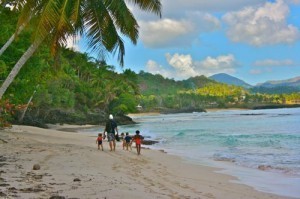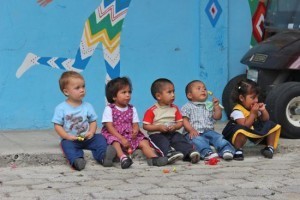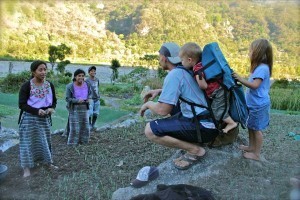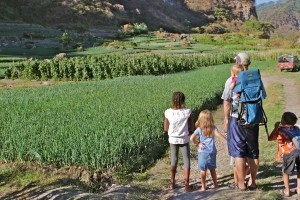Rolf Potts's Blog, page 67
February 24, 2013
Michael Moynihan on the political contradictions of travel guidebooks
Vagablogging :: Rolf Potts Vagabonding Blog
“There is an almost Orientalist presumption [on the part of travel guidebooks] that the citizens of places like Cuba or Afghanistan have made a choice in rejecting globalization and consumerism. From the perspective of the disaffected Westerner, poverty is seen as enviable, a pure existence unsullied by capitalism. [Lonely Planet: Cuba co-author Brendan] Sainsbury refers to Cuban food as “organic” and praises the Castro brothers’ “intellectual foresight [that] has prompted such eco-friendly practices as nutrient recycling, soil and water management and land-use planning.” Meager food rations and the 1950s cars that plod through Havana’s streets, however, don’t represent authenticity or some tropical version of the Western mania for “artisanal” products, but, rather, failed economic policy. It’s as much of a lifestyle choice as female circumcision is in Sudan.”
–Michael Moynihan, “Leftist Planet,” Foreign Policy, Sept/Oct 2012
Original article can be found here: Michael Moynihan on the political contradictions of travel guidebooks
February 22, 2013
Vagabonding Case Study: Traci Wightman
Vagablogging :: Rolf Potts Vagabonding Blog
Traci Wightman
Age: 33
Hometown: Mason, Michigan (USA)
Quote: “The feeling of being out on the road is one of the most freeing experiences I have ever had. Unlike before, this road has no targeted end date.”
How did you find out about Vagabonding, and how did you find it useful?
I came across the books a few years ago at Barnes & Noble, at a time when I was looking for inspiration/motivation to travel. I’ve read through the book several times, looked up several of the resources and have read through many of the pages on the vagabonding site. I find it useful in helping me to get organized as I prepare for my upcoming journey. There are things mentioned in the book that I did not think about as a consideration for vagabonding, but have them on my task list.
What is your job or source of travel funding for this journey?
I have been working as a grant writer/coordinator at a state agency for almost 8 years. I will be cashing in my 457 account from that position to help support my on-going expenses. I’ve been putting money into this account, for the eventuality of my transitioning into a new job/career else where.
Do you plan to work on the road?
Yes, I do plan on working while abroad. My career of choice is international development and I need field experience. I will be working with local organizations on short-term projects to build up more field experience.
What was the reaction of your friends/family/colleagues as you planned your trip?
Many of my friends/family/colleagues are excited for me, but also concerned about my taking a big leap into the unknown. Others are upset with me.
I spent a year abroad as a high school exchange student about 15 years ago, then I spent another year studying abroad while in college about 10 years ago. Upon my return from my second year abroad, a family member said to me, well, I hope you got it all out of your system, so that you can now settle down and get a decent job. In the last 8 years, I took a couple two-week trips while working, but it’s not the same feeling as having one’s possessions on their back, and carrying their life with them as they are moving in and out of other people’s lives.
Any tips or lessons learned from the travel-preparation process?
Something I’m realizing about all of this is it’s a process, and everything happens in its own time. From packing up the home to canceling services or forwarding mail, this all has to be done at a certain stage in the process. I am still looking for a good method of receiving mail, since I will be getting rid of my current dwelling.
A tip for preparation, don’t sweat the small stuff. If I got anxious about everything that is changing right now, it would make this process less fun. I still have about 2 months before I head out, and I would be driving myself crazy if I worried about each minute detail and not trusting that this will all happen in due time.
How long do you hope to spend on the road?
At this point, I plan to be on the road as long as it takes. I will not be constantly on the move, I have done that before. I would like to work on short-term projects for 3-6 months at a time, and then take a few weeks to see different things as I move towards the next destination.
Which destinations do you hope to visit?
I will be starting in Guatemala to attend a Spanish school and work with a local non-profit for a few months. I want to become more proficient in Spanish before moving into areas I am less familiar with. From there, I would like to visit as many of the countries in Central and South America as I can.
Which experiences are you most looking forward to?
More than anything, I am looking forward to the adventure of it all. I also look forward to interacting with the expat communities again. I guess I could say I am a bit of a travel junkie, and have not been on a big adventure in several years. The feeling of being out on the road is one of the most freeing experiences I have ever had. Unlike the last couple times, this road has no targeted end date.
What are you packing for the journey?
I’m heading to a warmer climate and will be taking more appropriate clothing, plus good hiking/walking shoes, sandals, and dress shoes. I will have my laptop and camera, plus ancillaries. I am still researching the remaining items I would like to include in my pack, including camping hammock, light-weight sleeping bag, etc.
Do you have any worries or concerns about the journey?
I guess my biggest concern is how my dog will handle all of this change. Once I’m in a position to have a regular dwelling again and working on longer projects, I will send for him. In the meantime, he will remain with family.
How can we best follow your adventures?
I will be posting to my blog: http://traclynne.blogspot.com/
Website: tlwightman.com
Are you a Vagabonding reader planning, in the middle of, or returning from a journey? Would you like your travel blog or website to be featured on Vagabonding Case Studies? If so, drop us a line at casestudies@vagabonding.net and tell us a little about yourself.
Original article can be found here: Vagabonding Case Study: Traci Wightman
February 21, 2013
Towns of Boring and Dull plan epic celebration of all things uninteresting
Vagablogging :: Rolf Potts Vagabonding Blog
We all know that most cities are desperate for tourism money in this lousy economy. Some are going to great lengths to generate interest. Now a PR man (or woman) has looked at a map and cooked up the tourism industry’s latest publicity stunt: Two towns, separated by an ocean and thousands of miles, plan to launch a joint promotional effort to entice tourists with a day of celebration that boldly promises to be a total snooze.
It all began when a UK traveler, passing through the west coast of America on vacation, happened upon a community with a name similar to his own hamlet back in Scotland. Before long, the Oregon town of Boring had itself a “sister city” called Dull, a tiny Scottish village.

A real town in Scotland. Pretty place. Not much in the way of nightlife, however.
Now an article in the UK paper Telegraph describes Boring and Dull’s plan to make August 9th— the anniversary of their union , or whatever—a mutual, transatlantic day of celebration of all things uninteresting. The intention is to draw free publicity to their respective communities’ charms. With a low population, rainy climate, and eight hours’ time difference, it is still unclear whether Boring and Dull’s event will be, well, eventful.
Original article can be found here: Towns of Boring and Dull plan epic celebration of all things uninteresting
The ten days holiday, my way
Vagablogging :: Rolf Potts Vagabonding Blog

“Yes, we can just try to do it in about ten days.”
It is a strange feeling dawning on me when I realize I AM the object of the conversation. It has been said quite a few times on Vagabonding before, how the ten days holiday can be a step towards the opening of the third eye of travel but… it just SUCKS when it applies to YOU: an ex long-term traveler bound by a life of travel to live a “normal life”. Well, researching Southeast Asian alienated youth headbanging at the rhythms of noisy, loud music is not so normal, nor it is bad. It is surely quite fun. But being required to stay put because you have to assist the students with tutorials, well, that leaves only the Easter window as a tiny possibility of a much needed foray into some sort of adventure. Because of course, I would not be content on going to Thailand, and relax on the first beach. If I went there, I’d find a more suitable position trying to chase down some Muslim rebels in the jungles around Pattani. But… can you do that in 10 days? I am afraid not. Taking long stretches of travel at a time – in my case, one year periods, more or less – is a serious problem to adjust to when you are planning another foray. Because you always want more. You NEED more. There is nothing you can do, your own cells have mutated and you are now ready to front the group of the X-Men of travel, like Wolverine, your bones are adamantium and won’t rest if not jarred against the rocks of a forgotten camping ground next to some forgotten border.
“Mmmmm….” We look at each other straight in the eyes.
“Maybe we are not going anywhere, are we?”
“No no, check that flight price, c’mon…”
“Wait! Are we going TO FLY??”
Sometimes I wish I were a simpler man, like Lynyrd Skynyrd so poetically put it. But travel, luckily, made me not. That’s why I have adamantium bones. What about you? Can you take it?
Original article can be found here: The ten days holiday, my way
February 19, 2013
Snapshot from Chieow Laan Lake, Thailand
Vagablogging :: Rolf Potts Vagabonding Blog
A jungle night is not quiet and the grey dawn was a rude awakening after a night of laying, late, beneath an ebony sky, drowning in the silver specks that pepper the universe. I wonder what we look like from light years away? We lay on the dock and watched for the last remnants of the Leonid meteor shower. We’ve watched it for years from wherever late fall finds us. Every year we tell the story of how Ezra thought, when he was three, that it was the Leonid “meat-eater” shower and was terrified that the universe would begin raining dinosaurs on our back yard.
“Look at the stars… look how they shine for you…” Hannah sang softly. Some of the travelers joined her. There was laughing and stories were swapped as Venus rose, like a diamond, above the jagged ink black wall of cliff that lines the lake. We’ve only seen stars like this a couple of times on our travels: deep in the jungle at Tikal, and on the cold dark sands of the Sahara. In the darkness the lake’s inky black mirrored the sky and the stars twinkled below, as well as above us.
Chieow Laan Lake is man made. Hydro-electric dams were built in 1982 and an enormous valley was flooded and a spider web of narrow inlets and deep crevasses were formed to create an unnatural wonder in the mountains of south western Thailand. It’s inside Koh Sak National Park, which was created to stop logging and protect the animal populations from poachers. The villages that dotted the valleys were relocated, land was granted and exclusive fishing rights to the lake designated to the original inhabitants.
For the few folks who take the time to find their way to the handful of raft house and tree-top eco-resorts on the lake, the reward is paid out in bird song and gibbon voices, insect drone and the occasional splash of lazy fish, breaking the surface. There are about ten villages with 20-30 bamboo houses each. Some newer ones are being built atop floating drums instead. There’s no fear of the lake being overcome with resorts like so many other places because development is tightly controlled by the government and the building can’t take place on land. It takes about an hour, from the pier on the dam, to the raft village we stayed at, by long tail boat. Long tail boats are classically Thai. They’re wooden boats with what look like car engines retrofitted with a long shaft propellor. Skimming across the surface of a flat calm lake they remind me of the tip of a cattail reed being along at an alarming rate by an angry dragonfly. It’s all fun and games until a dragonfly loses a prop; it dropped straight off the shaft, unrecoverable in the deep blue. Our boat and one other pulled alongside and while the men made the repair I noticed how very like drawings in a Dr. Seuss book the islands of Cheow Lan lake look. I almost expected to see a Lorax swinging with the monkeys between the trees.
Dawn breaks grey between the limestone cliffs, with mist trapped like cream in a tea cup until the sun’s long fingers stir it from the water’s surface, painting the world in blues that breathe and living greens. We took our tea cups into the boat and slipped out between the islands in search of wildlife before breakfast. There are wild elephants, two types of rhinoceros, tapir, monkeys of several varieties and a rainbow of birds that are protected within the national park, among many other things that we held our breath in the mist, hoping for a glimpse of.
The children whispered as we added Macaque monkeys to our list of primates seen in the wild. Two toucans, enormous ones, not the smaller ones like we saw at Tikal, swooped on black wings with sunlit yellow centers, like living stained glass windows to a branch above our heads. We listened as they talked; their deep, “Awk-Awk… Awk” echoed off of the cliffs around us four times, fading into the distance.
“This looks like Jurassic Park!” Gabe whispered as Tony leaned out to try to capture a toucan on film at just the right second. I took my eyes off of the birds for a second and studied the interlocking face of every shade of emerald that makes up the imposing wall that is the rainforest; a living shield around a fragile eco-system. Hannah says that all that these peaks are missing is a dragon to swoop down on leathery wings and strafe the valley with fiery breath; it certainly has the feel of another world, where dragons and giant lizards are possibilities, just beyond the filmy veil of reality.
Original article can be found here: Snapshot from Chieow Laan Lake, Thailand
February 18, 2013
Family Vagabonding: Why Long Term Travel is Good For Children
Vagablogging :: Rolf Potts Vagabonding Blog
There was a time when I lived a ‘normal’ life. My husband and I had the mortgage, the career, two cars and 3.5 kids. We had a house full of furniture and nice things. It was an okay way to live. I was relatively happy.

Walking on the beach in the Dominican Republic
Then somehow that all changed. Today you’ll find me exploring from Alaska to Argentina in a veggie powered truck, now with five kids — homeless, wandering, a vagabond family with few possessions — and strangely more fulfilled. Life isn’t perfect, but it holds much more adventure and fascination.
Of course, the idea of nomadic living with children doesn’t fit into society’s ‘norms’. Children need ‘stability’, routine, friends and school. As one man put it, “I think this is insane. Fast forward 20 years. You are going to have 5 messed up kids. You can’t comprehend this. Most people can. Stop this insanity and give your kids some stability, friends and a life. [Traveling] is selfish, irresponsible and idiotic. Grow up.”
This man worded it more gently when he said, “I happen to think it is a bit irresponsible of you to put your kids’ futures in jeopardy to satisfy your need for travel. What [you are doing] is just risky.” Despite his more tactful approach, he still depicts the preconceived notions our culture regards as true. How will your children get good grades, go to college and find a good job, if their childhood is spent wandering the globe? Certainly vagabonding can’t be good for kids. Can it?
Of course the purpose of this article is not to contend that every family should be nomadic, but to tackle some of the misconceptions in regards to traveling long term with children. In Rolf’s book, Vagabonding, he outlines some of the many benefits of a wandering lifestyle. These advantages are not just beneficial for adults, but for children too.
Is this an unorthodox way to raise children? Yes, and isn’t it great? Why not create a new definition of what ‘normal’ family life looks like? We need more kids who grow into adults with an expanded global awareness, developed creative thinking skills and the ability to effectively handle change. Our kids don’t have to follow the formula of graduation, career and mortgage (and vagabonding doesn’t prevent them from doing those things, either, if that’s what they really want.)
Here’s some of the biggest reasons that long term travel and vagabonding as a family is good for children:
1. It gives them permission (and the tools) to follow their dreams

In Huehuetenango
For many people, long term travel seems like some ‘pipe dream’ that exists in that nebulous ‘someday’. In Rolf’s own words, “we see long-term travel to faraway lands as a recurring dream or an exotic temptation, but not something that applies to the here and now. Instead — out of our insane duty to fear, fashion and monthly payments on things we don’t really need — we quarantine our travels to short, frenzied bursts.”
When we travel long-term with our children, we help them to see that we can pursue the things we really want now — experiences that are memorable and meaningful — instead of waiting for a someday that will never come. It also helps them to get perspective on what truly matters in life — such as experiences over possessions — creating a strong foundation that will guide them in making long-term lifestyle choices. Vagabonding creates a unique outlook on life. It helps your children to increase their options and expand their possibilities.
2. It gives them more options for earning money when they become adults
In American society today (as well as other cultures), our ability to earn a decent income is dependent upon our capacity to ‘jump through hoops’. We have to get the grades so we can get the degree so we can build the resume. However, this is rather a limiting system. If you don’t fit into the holes just right, you become essentially unemployable (which can be a great thing).
Vagabonding with children teaches them to think outside of the box of money=job. When you travel to foreign countries, you see first hand that the majority of the world’s population earns a living from running a small business. Whether they fix cars, sell goods or offer personal services, their personal economy isn’t dependent on large corporations, but only on their own ingenuity. From Rolf again, “Vagabonding is about gaining the courage to loosen your grip on the so-called certainties of this world… It’s taking control of your circumstances instead of passively waiting for them to decide your fate.” In reality, this offers more security than the alternative.

Hiking in Guatemala
As you slowly explore the world with your children, their creativity for earning money is ignited. They’ll open their own businesses (and it’s very easy to do so abroad), selling popsicles or home made goodies, teaching English or music lessons, or even writing about their experiences. They become independent, and learn to look to themselves to provide for their needs, rather than to some company who can give them a job.
3. It teaches them to live simply and let go of ‘stuff’
Naturally, if you take off to travel the world long-term, you can’t take everything with you. You have to leave some things behind, maybe things that you’re emotionally attached to. This is especially true for children.
Yet this experience in and of itself is one of the major benefits of vagabonding. It forces you to reevaluate your relationship with stuff. “Travel by it’s very nature demands simplicity.” And your children can learn to do it too — naturally and happily — if it’s approached with the right attitude.
When we first began to travel as a family, our oldest child was only four, our youngest two months old. They were attached to some of their things, but as we prepared for our upcoming move to Costa Rica, my and my husband’s enthusiasm for the adventure outweighed the discomfort of getting rid of stuff. We allowed them to choose a few prized possessions, but then reminded them that the other belongings we were eliminating so we could go have fun together as a family on the beach, or exploring jungles and waterfalls.
Fast forward six years (my oldest is now 10) and while they still enjoy owning things (although it’s not very much) they’ve learned to value the experiences that travel offers. Anytime we need to eliminate once more so we can begin a new adventure, resistance is minimal, and the excitement for exploring a new place takes center stage. They’ve learned this as a direct result of our vagabond lifestyle.
4. It teaches them how to live in the world
 Again from Rolf’s book, “The discoveries that come with travel, of course, have long been considered the purest form of education a person can acquire. ‘The world is a book,’ so goes a saying, ‘and those who do not travel read only a page.’ Vagabonding is all about delving into the thick plots the world promises, and the more you ‘read’, the better you position yourself to keep reading.”
Again from Rolf’s book, “The discoveries that come with travel, of course, have long been considered the purest form of education a person can acquire. ‘The world is a book,’ so goes a saying, ‘and those who do not travel read only a page.’ Vagabonding is all about delving into the thick plots the world promises, and the more you ‘read’, the better you position yourself to keep reading.”
Travel, and specifically long-term travel, is addictive because it is a process of discovering the world and learning to see it in a new way. It helps you develop an attitude of open-mindedness toward life, people and learning. It lessens prejudices and preconceptions, and helps you to find balance between planning and unpredictability. It develops confidence by teaching you that you don’t have to know exactly how you’ll do something, just that you will.
Vagabonding teaching children to set their own pace and find their own way. It teaches them to respect themselves and others, regardless of differences. It trains them on how to comfortably handle change and new environments — and to enjoy it. Long-term travel instructs kids on how to stop fretting about life’s possibilities, and instead have the courage to seize them.
5. It shows them the true meaning of stability
One of the biggest arguments against traveling with children is that they need ‘stability’, routine, structure and the security of a familiar home. But what happens to the child who is raised in that environment, and then it’s all taken from him, due to death, job change or other external circumstances?
How about the child that has all those ingredients, but lacks loving parents, or whose home is filled with abuse. Stability is not a result of staying in one place and having predictable structure day after day (in fact, you might argue that that creates instability and the inability to effectively handle change.)
Stability comes from within, and is nurtured in children by loving, caring parents who help their kids learn how to deal effectively with change (that will inevitably come), and to rely on what (should be) unchangeable — our love for one another. This can be taught to kids anywhere in the world.
 Routine can also be a regularity. I can read to my children every night whether we’re in a hostel in India or renting a house in Guatemala. We can share breakfast each morning, spend time pursuing our education, and explore the nuances of a new destination. Home can be wherever we are as a family, as long as there is love and mental stability on the part of the parents, and family rules that are clearly understood and lived by.
Routine can also be a regularity. I can read to my children every night whether we’re in a hostel in India or renting a house in Guatemala. We can share breakfast each morning, spend time pursuing our education, and explore the nuances of a new destination. Home can be wherever we are as a family, as long as there is love and mental stability on the part of the parents, and family rules that are clearly understood and lived by.
Long-term travel as a family is not to be confused with family vacations. Vacations are often short, hurried and stressful, where the goal is to fit as many fun things into as short a time as possible, or to ‘escape’ from regular life.
Contrast that to vagabonding where slow travel is the ideal. You might spend months, or years, in a destination exploring it’s nuances, becoming fluent in the language, and being immersed in the culture. Travel is life, and life is travel. There’s very little separation. It’s an ongoing experience where the duality of life is united as you rediscovery reality, and you learn to be sensitive to what is taking place in this very moment.
Isn’t that a perspective you would like your children to have?
Rachel Denning is mother to five incredible kids, long-term traveler and family travel expert. She’s currently slow-traveling from Alaska to Argentina, and blogs about The Art of Family Travel as runs a How to Fund Your Travel Interview Series. Rachel is co-author to the book, Living Deliberately: How to Create a Ridiculously Awesome Life
Original article can be found here: Family Vagabonding: Why Long Term Travel is Good For Children
February 17, 2013
Our most important transitions are written into our journeys
Vagablogging :: Rolf Potts Vagabonding Blog
“Travel is as familiar as the experience of the body, the wind, the earth, and this is why at all times and in all places it is a source of reference, a ground of symbols and metaphors, a resource of signification. The anthropologist and historian of religions Mircea Eliade laments the absence of genuine ritual of initiation in modern life and suggests that “modern man has lost all sense of traditional initiation.” But perhaps it is only that the reality of passage has replaced the ritual, and the most important transitions we experience are written into our journeys, which make of our lives a procession and spectacle more engrossing and transforming than any ritual could possibly be.”
–Eric J. Leed, The Mind of the Traveler: From Gilgamesh to Global Tourism (1991)
(1991)
Original article can be found here: Our most important transitions are written into our journeys
February 16, 2013
Vagabonding Field Reports: Surviving my first armed robbery attempt in Argentina
Vagablogging :: Rolf Potts Vagabonding Blog
Cost/day: $40
What’s the strangest thing you’ve seen lately?
A gold coloured gun as it was being stuck at my nose by a young man on the streets of Mendoza. I’m no gun expert, but something felt weird about the gun. Also, the young man holding it was smaller than I was and for some reason, that made me feel more surprised at the experience than afraid. But the gun sticks out in my mind very distinctively.
The violent and terrifying streets of Mendoza, Argentina
Describe a typical day:
Mendoza is all about the wine. Either you’re drinking it in the restaurants, at the vineyards or just in your hostel. Mendoza is flowing with great tasting and inexpensive wines. A typical day is usually walking along the tree lined streets or renting a bike out in the nearby wineries. We almost always pack our own lunches but for dinner, we’ll buy a couple of steaks and cooking them in our hostel. The quality of the beef is so high that it’s almost impossible to mess up, even for a terrible cook like myself.
Describe an interesting conversation you had with a local:
I talked to an older French fellow who had recently retired and purchased an old, rundown winery as a retirement project. I asked him if he knew anything about wines or even if he had set out to get into the wine business. Basically, his answer was “no” across the board. After living in Argentina and working for a French company for a while, he decided not to go back to France just spontaneously decided on buy a winery. He thought it would be fun. So he’s now poured his life savings into the business and is living out his life in the beautiful landscapes which is the Mendoza wine region. Talk about living life on your terms and being open to possibilities.
What do you like about where you are? Dislike?
Argentina, compared to most of South America, is certain well developed. Also, the wine is really great value. It’s been a while since I was in Australia but I would say that the two are reasonable comparisons in terms of value for your dollar.
Coming from Bolivia, I found Argentina to be much more money focused. Basically, everyone starts asking for tips after you cross the Bolivian/Argentinian border. It was a stark contract to the experience on the Bolivian side where money is certainly less plentiful but not as powerful a presence.
Describe a challenge you faced:
The attempted armed robbery was the biggest challenge I faced in Argentina. After 13 months of being on the road, this was my first robbery attempt. The thugs didn’t get what they wanted – they wanted my wife’s backpack – since, basically, they weren’t willing to shoot me in the streets for it and I wasn’t physically intimidated by them. In the end, we ran past/around them and make a scene that pretty much scared them off.
What lesson did you learn?
Basically, if you want to rob someone and you do it in plain daylight, it’s not enough just to have a gun. You need to convince the other person that you are serious. I don’t plan on robbing anyone of course, but if I did, I’d start by being as intimidating as I possibly could before I pulled the gun out.
Where next?
Flying back to Toronto to end our journey where it began 13 months ago.
Original article can be found here: Vagabonding Field Reports: Surviving my first armed robbery attempt in Argentina
February 15, 2013
Special February 2013 Fares for Multi-Stop Tickets on BootsnAll
Vagablogging :: Rolf Potts Vagabonding Blog
One of my favorite things about BootsnAll’s new flight finder, Indie, is how easy it is to put multi-stop trips together and just dream. Dream about that next big trip that we might take. Dream about finding an awesome adventure that might appeal to someone else. Dream about all the possibilities.
A cool part of my job is searching and coming up with interesting trips around the world and finding a good price. With Indie, it’s super easy (and fun!) to plug in different destinations, move them around, play with dates, and try to find the best trips.
The five trips below are some recent ones I’ve found. But I’d like to challenge you to find some awesome trips on Indie. What are the coolest routes and most affordable options that you can find? Head on over to Indie, register for an account, and start searching!
Check out these five fares that we’ve found on Indie, BootsnAll’s Multi-Stop Trip Planner:
Europe and South Africa – $2,557 - New York City > Lisbon >overland> Paris > Istanbul > Johannesburg >overland> Cape Town > New York City $2,557 taxes and fees included.
RTW from Melbourne – $3,373 - Melbourne > Los Angeles > New York City > Dublin > Melbourne from $3,373 taxes and fees included.
Explore Japan and India – $1,881 - Seattle > Tokyo > Delhi > Seattle from $1,881 taxes and fees included.
Round Asia from Brisbane – $1,902 - Brisbane > Phuket > Delhi >Kathmandu >overland Beijing >overland> Shanghai > Brisbane from $1,902 taxes and fees included.
Europe from DC – $1,570 - Washington DC > Budapest > London > Reykjavik > Washington DC from $1,570 taxes and fees included.
If you are looking for something a little different in your round the world trip, then go ahead and plan your own trip on Indie, our multi-stop trip planner. And don’t forget to sign up for BootsnAll’s RTW newsletter, delivering special deals, RTW trip planning advice, and resources via email every single month. We also have a Facebook fan page and Twitter page, so be sure to like and follow those to keep up to date on all your RTW travel needs.
Original article can be found here: Special February 2013 Fares for Multi-Stop Tickets on BootsnAll
February 14, 2013
Travel with a THICK open mind
Vagablogging :: Rolf Potts Vagabonding Blog

Thick as a Brick? - picture credits:Viqi French/Flickr
This is my gift to all the lovers – and all the others, too – on this Valentine’s Day:
“Culture is public because meaning is. You can’t wink (or burlesque one) without knowing what counts as winking or how, physically, to contract your eyelids, and you can’t conduct a sheep raid (or mimic one) without knowing what it is to steal a sheep and how practically to go about it. But to draw from such truths the conclusion that knowing how to wink is winking and knowing how to steal a sheep is sheep raiding is to betray as deep a confusion as, taking thin descriptions for thick, to identify winking with eyelid contractions or sheep raiding with chasing woolly animals out of pastures. “ Geertz, C., “The Interpretation of Cultures: Selected Essays”, p. 14
We do not have to be anthropologists when we travel, but what Clifford Geertz said in 1973 is pretty damn actual even today. By crossing this world with a preconceived idea of our culture as the lens through which EVERY other culture should adapt to our own travelling experience, we incur in the gross mistake of observing reality in what Geertz considered the “thin” aspect. Thus, thin becomes our perception of the world: “thin” is the travel experience we get if we gallivate around the globe by sticking with our own group, by enlarging the safety net of our experience to the thinness of a hostel and its dwellers. Too easy to try to understand the world through the demystifying lens of the English language, the Anglo-American perception, the thinking that by being there, in that remote locale, we have already established deep contact. Unfortunately, it is not like that. And things seem not to have changed in the past 40 years, and well, they have become increasingly more complex, as more complex is the fabric of the postmodern world. Next time, try to think if your effort is going towards the THICK, more than the thin. We are humans and we have to make mistakes to improve ourselves; nevertheless, make sure you get mistaken along the right way. Make THICK mistakes. That way, you will feel fuller inside, and slowly you will prefer to stay rather than to go, because this is the real essence of cultural THICKNESS. A whole different way to travel, looking inward, deeply, and all around you.
Original article can be found here: Travel with a THICK open mind
Rolf Potts's Blog
- Rolf Potts's profile
- 323 followers





